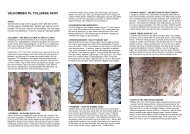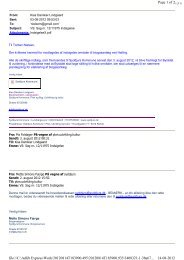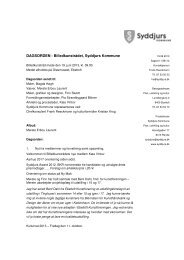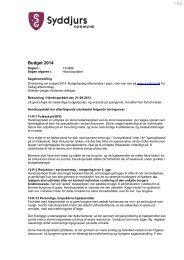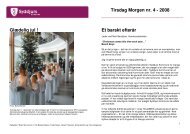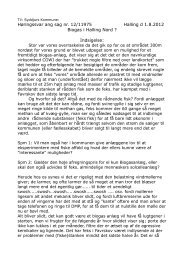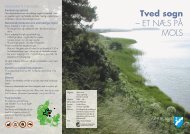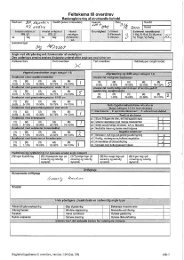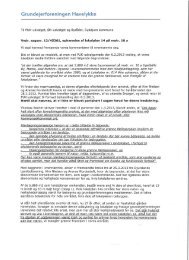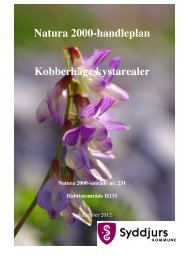111 U h .
111 U h .
111 U h .
Create successful ePaper yourself
Turn your PDF publications into a flip-book with our unique Google optimized e-Paper software.
Villefosse, H . de 1895<br />
Voss, O . & M. 0rsnes<br />
Christensen, 1948<br />
Wad, G. L. 1916<br />
Werner, J .1954<br />
Windelhed, B. 1980<br />
Worsaae,J.J. A. 1877<br />
0rsnes, M . 1969<br />
SUMMARY<br />
Le Tresor d'argenterie de Boscoreale. Paris.<br />
Der Dollerupfund. Ein Doppelgrab aus der romischen Eisenzeit.<br />
Acta Archaeologica XIX.<br />
Fra Fyens Fortid. Samlinger og Studier, vol. II. København.<br />
Fibeln aus Aquileia. Estratto dal Volume "Origines((. Anno 1954 -<br />
delle Rivista Archaeologica dell'Antica Provincia e Diocesi di Como .<br />
Como.<br />
Diskussion av de rumsliga sambanden vid studier av utvicklingsfårlopp<br />
inom fOrhistoriska kulturlandskap. Kontaktstencil<br />
18. Umeå.<br />
Om Bevaringen af de fædrelandske Oldsager og Mindesmærker<br />
i Danmark. Aarbøger for nordisk Oldkyndighed og Historie .<br />
Forord til genudgivelsen af Sønderjyske og Fynske Mose.fo.nd af C.<br />
Engelhardt. København.<br />
Bendstrup - A Princely Grave from the Early Roman Iron Age: Its<br />
Social and Historical Context<br />
In 1869 a 'princely grav«;: from the Early Roman Iron Age was discovered in a barrow on<br />
Bendstrup mark, the town of Bendstrup, Hvilsager parish, Sønderhald district, Randers<br />
county. Some of the grave goods were purchased for a private collection at the manor<br />
Valbygård near Slagelse, where they are still to be found (fig. 3-6) .<br />
Through arecently discovered exchange of letters between the seller/finder, Sophus<br />
Andreas Bergsøe, and the buyer, the owner of Valbygård, August Villads Bech (nephew<br />
and uncle, respectively), it has been possibIe to reconstruct the find as a whole from among<br />
the many objects ofthe Valbygård collection (fig. 1,2, and 7) .<br />
The grave was probably an inhumation grave; the many clay vessels mentioned but not<br />
preserved indicate that this type must be classified under the com mon type of pottery<br />
grave of Central and Northern J utland. I t was found in a barrow beneath a pile of large<br />
stones. The orientation was said to be north-south. The grave goods preserved consist of<br />
two silver fibulae with twisted gold wires, 4 cast lion's claws, 3 small raund "bases", and a<br />
"bowl" lacking a bottom, all of bronze, together with 4 fossils, 2 ammonites and brachiopods.<br />
A large amber bead could als o be identified as part of the find. Together with these<br />
objects there was a quantity of pottery, and a considerable accumulation of rust on the<br />
outer side ofthe bronze "bowl" must come from a rather large iran object, possibly a knife,<br />
which had broken off after excavation. However, it must be noted that Sophus Bergsøe<br />
first arrived at the site after the find had been dug up, as mentioned several times in the<br />
150<br />
description. Thus he refers (and interprets?) the information provided by the excavator; he<br />
personally checked through the soil which had been dug up.<br />
DESCRIPTION AND DATING OF THE FIND<br />
The silver fi bul ae (fig. 9-11)<br />
The fibulae are single-jointed and cast, with a length of 5.5 cm and a weight of c. 25 g each.<br />
The fibulae must be placed typologically in Almgren's gr. IV: strongly profil ed fibulae and<br />
subsequently in the 1st main series: with a bow-head and an openwork catch-plate. They<br />
can most closely be compared with fig. 67 (Almgren 1923, p. 34 fI). This fibula type has an<br />
eas tern main distribution, concentrated in the Austrian Alpine region, Bohemia, and<br />
Eastern Germany. It occurs less frequently towards the west, and in Denmark it is not<br />
found at all, according to Almgren. Chronologically it ought to be ascribed to the transition<br />
between the Late La Tene and the Early Roman Iron Age.<br />
However, the Bendstrup fibulae are in a class of their own, due to the animal heads.<br />
Early Roman Iron Age fibula types with a well-modelled ani mal head on the bow are<br />
known from the Celtic-Illyric eastern Alpine region, with a concentration south of the<br />
Roman Danube border Qahn 1952, Werner 1954). Moreover, there is an isolated Danish<br />
group with a concentration on Djursland (fig. 20) . The Danish examples are: Hoby on<br />
Lolland (fig. 12) and St. Grandløse, Holbæk county (fig. 13), which are ofsilver. All other<br />
animalheaded fibulae, with a single exception, can be attributed to one district, Sønderhald<br />
in Randers county: Ryomgård gr. 2 (fig. 14), Langkastrup gr. 14 (fig. 15), Langkastrup<br />
II, gr. B (fig. 16), Virring gr. 22 (fig. 17), and finally Torrild mark, Århus county<br />
(fig. 18) . This last-named is made of silver; all those from Djursland are of bronze.<br />
The basis for the typologi cal classification of the Bendstrup fibulae in the local environment<br />
is comprised of the individual stylistic elements of the animal heads: I) the animal<br />
heads full face, 2) the animal heads in profile, 3) the shape of the eyes, and 4) the shape of<br />
the ears. These individual elements are illustrated in fig. 19. Upon this basis, it is possibie<br />
to divide the animal heads into 4 typologi cal groups: A,B,C, and D .<br />
The A-group includes Bendstrup (A I) and Langkastrup gr. 14 (A 2) . The heads are<br />
well-modelled with upper and lower jaws, carefully executed eyes consisting of several<br />
concentric circles and ovals which make them appear to "see.", and small "smile .wrinkles"<br />
(particularly pronounced on A I). The ears are shaped like small isosceles triangles. A I is<br />
of silver with a two-ply gold wire round the forehead. A 2 is of bronze and has a smooth<br />
silver wire round the forehead.<br />
The B-group consists ofHoby (B I), St. Grandløse (B 2) and Virring (B 3). Full face, the<br />
main line is straight (or faintly concave and with a sharply marked central line) . The lower<br />
jaw is missing on B3. The eyes are ornamental dots on B I - where there are 3 X 2 pairs on<br />
each fibula - or they lack entirely (B 2 and B 3) . The ears are long, nearly right-angled<br />
triangles with no modelled effect. B I is of silver with a frontlet of two-ply gold thread; B 2<br />
is completely of silver, and B 3 is of bronze.<br />
The C-group consists ofRyomgård gr. 2 (C I) and Langkastrup II gr. B (C 2) . The main<br />
line, full face, is Ion g and curved with distinct cheekbones and a pointe? upper jaw. The<br />
lower jaw is weak (or may lack entirely) on C 2. The eyes are two concentric ovals (C I<br />
and seemingly C 2), the ears are long isosceles triangles - C I with a plastic modelled<br />
effect, C 2 faintly engraved. Both fibulae are of bronze, C 2 quite corroded and therefore<br />
with rather vague features.<br />
The D-group consists of the silver fibula from T orrild mark. The animal head, full face,<br />
has the same form as that of the B-group and the lower jaw is missing. The eyes are<br />
distinct, with small amorphous bumps, and the ears are extended with convex sides and a<br />
strongly modelled effect.<br />
151



